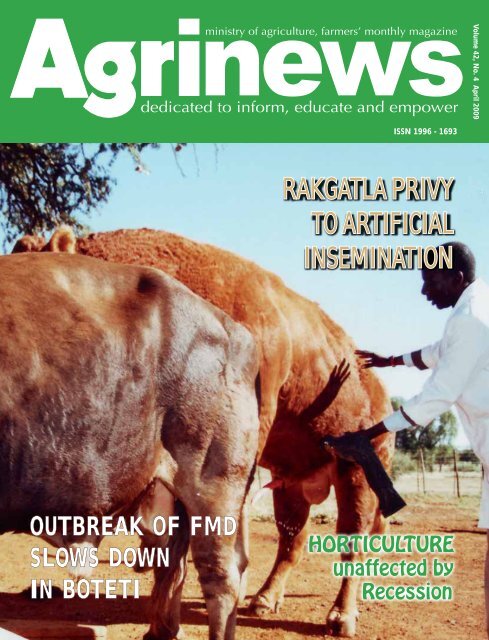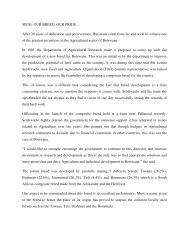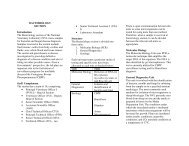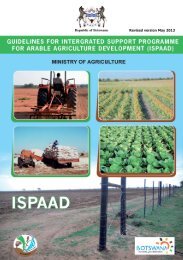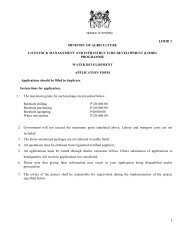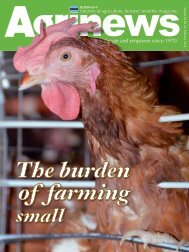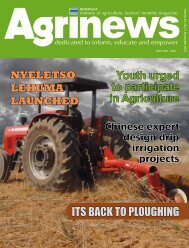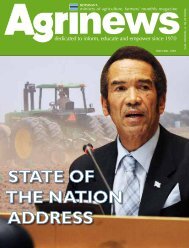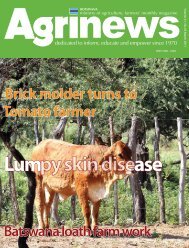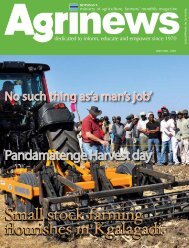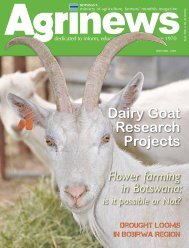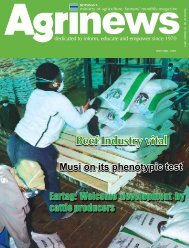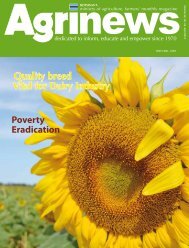April 2009 Agrinews (.pdf file) - Ministry of Agriculture
April 2009 Agrinews (.pdf file) - Ministry of Agriculture
April 2009 Agrinews (.pdf file) - Ministry of Agriculture
Create successful ePaper yourself
Turn your PDF publications into a flip-book with our unique Google optimized e-Paper software.
Volume 42, No. 4 <strong>April</strong> <strong>2009</strong><br />
ISSN 1996 - 1693<br />
RAKGATLA PRIVY<br />
TO ARTIFICIAL<br />
INSEMINATION<br />
OUTBREAK OF FMD<br />
SLOWS DOWN<br />
IN BOTETI<br />
HORTICULTURE<br />
unaffected by<br />
Recession<br />
<strong>April</strong> <strong>2009</strong>
A G R I N E W S<br />
<strong>April</strong><br />
2 0 0 9<br />
<br />
Editorial<br />
c o n t e n t s<br />
ISPAAD Anticipated to Yield Positive Results<br />
<br />
<br />
<br />
Addressing a press conference in<br />
Gaborone , Mr Kgathi said many<br />
beneficiaries were looking after<br />
their crops at the lands instead <strong>of</strong><br />
spending time in their homes.<br />
De Graaff tours farms in Ngwaketse South<br />
<br />
De Graaff implored upon farmers to<br />
take agriculture seriously.<br />
<br />
Ethopians View Botswana Livestock Industry as excellent<br />
<br />
Outbreak <strong>of</strong> FMD in Ngamiland Slows Down Progress<br />
in Zone 4A (Boteti)<br />
<br />
Frost Management<br />
Rakgatla Privy To Artificial Insemination<br />
<br />
<br />
<br />
He said the outbreak in Ngamiland,<br />
which occurred in October<br />
2007, is considered under control,<br />
as there have been no clinical<br />
cases since 12th February <strong>2009</strong> in<br />
Spanplerk crush in Kareng extension<br />
area.<br />
Agric Research Launches RAEIN-Africa<br />
Mantirisi Prides Himself in Leatherworks<br />
<br />
<br />
Rakgatla uses semen from different<br />
exotic bulls, some as far as the<br />
Americas, Germany and England.<br />
He says that he prefers Brahman<br />
because <strong>of</strong> their size and for easy<br />
calving.<br />
<br />
Dairy Day<br />
Horticulture unaffected by Recession<br />
Hides And Skin’s Economic Value And The Current<br />
Economic Recession<br />
<br />
<br />
<br />
<br />
The market for his products is<br />
promising, and there is potential<br />
for growth. He sells his products all<br />
over Kgalagadi.<br />
Bee Absconsion<br />
<br />
Epena Ngatangue<br />
Kediretswe Pule<br />
Felix Mothatego, France Begensel and Tiroyaone Jeremiah<br />
Mokgarebe Motswakhumo<br />
Keabetswe Molebatsi<br />
Thabile Mokgwane, Abadilwe Ralehika, Mokwadi Keitsile &<br />
Baboloki Mosweu<br />
Hendry Toto, Pius Nkunda & Mothusi Tlale<br />
Honey bee colonies are very sensitive<br />
to disturbances and absconsion<br />
is an immediate response to a sudden<br />
deterioration.<br />
<br />
AGRINEWS<br />
Letters to the Editor<br />
P/Bag 003 Gaborone<br />
Tel: 3906769<br />
Fax:3956027<br />
MoA website: www.moa.gov.bw
MINISTRY OF AGRICULTURE<br />
<br />
Summer is subsiding and<br />
winter season is setting<br />
on. There is no need for<br />
a prophet to confirm this.<br />
Temperatures are dropping.<br />
Most vegetation does not<br />
enjoy low temperature.<br />
The vegetation condition<br />
especially grass has<br />
started showing signs <strong>of</strong><br />
deterioration by as it loses<br />
its green colour.<br />
In the process vegetation<br />
loses its nutritive value.<br />
According to a research<br />
study by international<br />
Livestock Centre for<br />
Africa on livestock and<br />
sustainable nutrient<br />
cycling in the mixed<br />
farming systems in Africa,<br />
Herbage mass also<br />
decreases after it reaches a<br />
maximum at flowering.<br />
Low herbage mass prevails<br />
from the late dry season to<br />
early wet season. Rains<br />
in the beginning <strong>of</strong> the<br />
rainy season triggers<br />
germination <strong>of</strong> herbage.<br />
The above scenario<br />
indicates that, it is obvious<br />
that the setting on <strong>of</strong> dry the<br />
seasons should ring bells<br />
to the livestock farmers<br />
that they should prepare<br />
a feeding strategy since<br />
the degraded vegetation<br />
would no longer support<br />
animals alone.<br />
The editor is concerned<br />
because a majority <strong>of</strong><br />
livestock farmers depend<br />
on the range land to feed<br />
their animals. Animal<br />
population is increasing<br />
while grazing land is<br />
stagnant. This will put<br />
pressure on the range<br />
land resulting in further<br />
degradation <strong>of</strong> herbage.<br />
May the first strategy for<br />
livestock keepers is to cull<br />
the herd. Sell and keep<br />
enough funds for buying<br />
supplementary feeds<br />
throughout the drying<br />
season.<br />
Another key issue is to<br />
decide the type <strong>of</strong> feed for<br />
the dry season. Locals soil<br />
are deficient in phosphorus<br />
so feeds containing the<br />
mineral such as Diculcium<br />
Phosphate should be a<br />
priority.<br />
Actually phosphorus<br />
supplementation should<br />
be performed throughout<br />
the year because local<br />
soils are deficient in it.<br />
Farmers are also advised to<br />
use concentrates <strong>of</strong> which<br />
some <strong>of</strong> them are produced<br />
locally for supplementary<br />
purposes. Lastly farmers<br />
should cultivate a habit<br />
<strong>of</strong> consulting with their<br />
Extension agents in times<br />
<strong>of</strong> need<br />
1
Anticipated to Yield<br />
Positive Results<br />
Article: France Begensel<br />
Photos: Henry Toto<br />
Kgathi stressing a point during a press conference meeting journalists about agric development<br />
The Integrated Support Programme<br />
for Arable <strong>Agriculture</strong> Development<br />
(ISPAAD) has been well received.<br />
Assistant Minister <strong>of</strong> <strong>Agriculture</strong>, Mr<br />
Shaw Kgathi was addressing a press<br />
conference in Gaborone. Mr Kgathi<br />
said many beneficiaries were looking<br />
after their crops at the lands instead <strong>of</strong><br />
spending time in their homes.<br />
He stated that government has spent<br />
P136million out <strong>of</strong> the allocated<br />
158.7million.<br />
The programme aimed at improving food<br />
security in the country, was introduced<br />
last year following the termination <strong>of</strong><br />
ALDEP III.<br />
Mr Kgathi said over 237 588 hectares <strong>of</strong><br />
land had been planted under (ISPAAD).<br />
More than 78 000 farmers were issued<br />
with seeds, totalling 2020 tonnes.<br />
He said the average yield estimates for<br />
cereals is 500kg/ha in the communal sub<br />
sector and 1500kg/ha in Pandamatenga<br />
while the average yields for pulses is<br />
250kg/ha in both sub sectors.<br />
The total estimated production is 93 000<br />
tones and 6500 tones for cereals and<br />
pulses respectively.<br />
The yield estimates and estimated<br />
production however will be monitored<br />
as the estimates could be affected by pest<br />
outbreaks, rainfall and frost occurrences.<br />
A total <strong>of</strong> 5707 tones <strong>of</strong> fertilizer were<br />
issued to districts out <strong>of</strong> which 5552 were<br />
distributed to 8226 farmers, whereas<br />
2020 tones <strong>of</strong> seeds were distributed to<br />
78 261 farmers.<br />
Mr Kgathi said the programme has been<br />
well received by farmers, adding that<br />
many people are now at the lands instead<br />
<strong>of</strong> spending time in their home villages.<br />
He said the impact <strong>of</strong> the programme is<br />
evident, as ploughing fields have now<br />
been turned into productive fields.<br />
The programme include among others<br />
cluster fencing, drilling and equipping<br />
boreholes for potable water within the<br />
identified clusters, provision <strong>of</strong> seeds and<br />
fertilizers.<br />
Nonetheless he said the recent floods<br />
had affected production, particularly in<br />
the Pandamatenga area including the<br />
elephants that destroyed fields in some<br />
parts <strong>of</strong> the country.<br />
Regarding the distribution <strong>of</strong> government<br />
farms, he said only 16 farms will be<br />
distributed <strong>of</strong> which two have been<br />
reserved to young farmers.<br />
He said his <strong>Ministry</strong> is still in the process<br />
<strong>of</strong> demarcating Banyana farm for effective<br />
usage, adding that the 149 000 hectare<br />
farm is underutilized.<br />
The <strong>Ministry</strong>, he said has in addition<br />
employed district coordinators whose<br />
responsibility is to check agricultural<br />
services and account for productivity in<br />
the districts.<br />
In addition, he said so far 579 farms have<br />
been demarcated, <strong>of</strong> which 243 have<br />
been allocated<br />
journalist from different media houses listening 2 Kgathi<br />
BOPA<br />
2
Degraaff taking a closure<br />
look dairy meal at BCA farmer.<br />
Article: Epena Ngatangue<br />
Photos: Henry Toto<br />
in Ngwaketse South<br />
The Minister <strong>of</strong> <strong>Agriculture</strong><br />
Honourable Christiaan De Graaff<br />
on the 2nd <strong>April</strong> <strong>2009</strong> toured some<br />
fields in the Ngwaketse South to get first<br />
hand information on level <strong>of</strong> farm yields.<br />
Minister De Graaff who was accompanied<br />
by the Acting Permanent Secretary in the<br />
<strong>Ministry</strong>, Dr. Seja Maphanyane expressed<br />
appreciation <strong>of</strong> what he saw. He told the<br />
farmers after the tour that he has no doubt<br />
in his mind that there are some farmers<br />
who have taken agriculture seriously.<br />
He said there are signs that some farmers<br />
utilized the Integrated Support Programme<br />
for Arable <strong>Agriculture</strong> Development<br />
(ISPAAD), noting that already more than<br />
94 000 metric tones <strong>of</strong> cereal is expected<br />
this season. The national cereal demand<br />
is about 200 000 metric tones.<br />
He however was not happy with some<br />
fields which have been left idling. He<br />
implored upon farmers to take agriculture<br />
seriously, noting that government cannot<br />
afford to be pumping money into<br />
agriculture when some Batswana are<br />
reluctant to utilize government support<br />
schemes.<br />
Minister De Graaff assigned some Senior<br />
<strong>Ministry</strong> <strong>of</strong> <strong>Agriculture</strong> <strong>of</strong>ficials to explore<br />
how the under-utilized fields could be<br />
better used. Farmers complained about<br />
high prizes <strong>of</strong> fertilizers and shortage <strong>of</strong><br />
labour.<br />
On a similar note, Minister De Graaff<br />
toured the <strong>Ministry</strong>’s Piggery and Dairy<br />
at Sebele.<br />
At the Piggery, the Minister said he was<br />
impressed by the quality <strong>of</strong> the pigs and<br />
hygiene at the area. He however said<br />
there is room for improvement.<br />
The <strong>Ministry</strong> buys pigs from South Africa<br />
for breeding and in turn sells them at<br />
subsidized prizes to registered local<br />
farmers.<br />
Minister De Graaff further said the<br />
intention is to expand ISPAAD to cover<br />
more commercial farmers<br />
At Botswana College <strong>of</strong> <strong>Agriculture</strong> Dairy,<br />
Minister De Graaff encouraged the staff<br />
to do more to increase milk production.<br />
Dairy cows feeding<br />
Degraaff admiring pigs
VIEW BOTSWANA LIVESTOCK<br />
INDUSTRY AS EXCELLENT<br />
Botswana to benchmark on how to access<br />
international beef markets.<br />
On top <strong>of</strong> that the delegation was<br />
impressed by the coherent linkages that<br />
exist with the local livestock sector.<br />
They were impressed by the ministry <strong>of</strong><br />
<strong>Agriculture</strong> structure and the extension<br />
service that starts from headquarters to<br />
regions, Districts and ends at field/farmer<br />
level through extension areas.<br />
Ethopian delegates touring the BMC<br />
Article: Kediretswe Pule<br />
Photos: Pius Nkunda<br />
After a week long tour <strong>of</strong> livestock<br />
projects, the 16 Ethiopian men<br />
delegation confessed that the<br />
Botswana livestock industry is excellent<br />
compared to theirs, though they have<br />
more livestock especially cattle.<br />
After a short brief by the Directors<br />
<strong>of</strong> Veterinary Services and Animal<br />
Production departments, in the <strong>Ministry</strong><br />
<strong>of</strong> <strong>Agriculture</strong> Head Quarters on the<br />
activities <strong>of</strong> the two departments the<br />
delegations visited livestock projects and<br />
institutions.<br />
The delegation visited the National<br />
Veterinary Laboratory (NVL), Dibete<br />
Ostrich Multiplication Unit, Botswana<br />
Meat Commission (BMC), Mosi Farm,<br />
Tswana Pride Chicken Farm, Feed-master<br />
Feed Processor and Hurvitz Group<br />
Feedlot.<br />
In particular the Ethiopians were<br />
impressed by the fact that a local<br />
corporation composed <strong>of</strong> natives only<br />
wholly owns BMC. In addition the<br />
delegation was impressed by the ability<br />
<strong>of</strong> the BMC to access international<br />
markets like<br />
the EU.<br />
T h e<br />
delegation<br />
revealed that<br />
Ethiopia sells live<br />
animals to the<br />
middle east only,<br />
adding that it is<br />
not pr<strong>of</strong>itable. They<br />
admired the fact that<br />
BMC is able to make pr<strong>of</strong>it<br />
through selling carcass or beef.<br />
On that note Ethiopians came to<br />
They also appreciated the relationship<br />
between MoA institutions such as NVl,<br />
BMC, Department <strong>of</strong> Research and<br />
<strong>Ministry</strong> Headquarter.<br />
According to the Ethiopians their<br />
institutions are disengaged mainly<br />
because <strong>of</strong> the federal system they use. In<br />
the system things are not run centrally, but<br />
regions run their affairs independently.<br />
The delegation however revealed that<br />
customer oriented reforms known as the<br />
Business Process Reengineering (BPR) is<br />
underway in Ethiopia to make regions<br />
work together.<br />
Ethiopia is proud <strong>of</strong> a large population<br />
<strong>of</strong> livestock. There are 40 million cattle,<br />
28 million sheep, 24 million goats and<br />
7 million equines (donkeys and horses).<br />
The objective <strong>of</strong> the tour was therefore to<br />
benchmark in Botswana’s seemly<br />
advanced livestock industry<br />
with a view to improve theirs<br />
<strong>April</strong> <strong>2009</strong>
OUTBREAK OF FMD<br />
IN NGAMILAND SLOWS DOWN PROGRESS IN ZONE 4A (BOTETI)<br />
Article: Epena Ngatangue<br />
Photos: Henry Toto<br />
<strong>Agriculture</strong> Minister Christiaan De<br />
Graaff regretted that the outbreak<br />
<strong>of</strong> 2007 Foot and Mouth Disease<br />
(FMD) in Ngamiland has slowed down<br />
progress and setback gains made in<br />
endeavor to declare zone 4a (Boteti) FMD<br />
free without vaccination.<br />
Minister De Graaff was briefing residents<br />
<strong>of</strong> Boteti recently on the control <strong>of</strong><br />
livestock diseases and the implications<br />
on the marketability <strong>of</strong> beef to export<br />
markets. He spoke more specifically<br />
on the possible upgrading <strong>of</strong> veterinary<br />
disease control zone 4a to a European<br />
Union (EU) export zone.<br />
He said since zone 4a directly shares a<br />
relatively porous border with Ngamiland<br />
(zone 2), where there is an active outbreak<br />
<strong>of</strong> FMD. Hence it cannot be declared<br />
FMD free without vaccination until the<br />
outbreak has been fully controlled.<br />
“In addition, livestock management in the<br />
two zone is mainly under a communal<br />
system, therefore there is a possibility<br />
<strong>of</strong> disease spreading from Ngamiland to<br />
zone 4a,” he told the gathering.<br />
Minister De Graaff said as long as the<br />
disease is still present in Ngamiland the<br />
World Organization for Animal Health<br />
cannot grant zone 4a the FMD free<br />
without vaccination status.<br />
The World Organization for Animal is an<br />
Intergovernmental Organization founded<br />
in 1924. It has its headquarters in Paris,<br />
France.<br />
It guarantees transparency <strong>of</strong> animal<br />
disease status world wide as well as<br />
collecting, analyzing and disseminating<br />
veterinary scientific information. The<br />
organization also provides expertise<br />
and promotes international solidarity for<br />
control <strong>of</strong> animal diseases.<br />
The organization also guarantees<br />
the sanitary safety <strong>of</strong> world trade by<br />
developing sanitary rules for international<br />
trade in animals and animal products.<br />
Minister De Graaff, however, assured<br />
residents that his <strong>Ministry</strong> would<br />
continue with the regular inspections<br />
and blood sampling <strong>of</strong> cloven/ho<strong>of</strong>ed<br />
animals in readiness to apply when the<br />
FMD situation in Ngamiland is fully<br />
under control.<br />
“It is also very important that when we<br />
go through the process <strong>of</strong> converting<br />
zone 4a to an EU export zone, there is<br />
no movement <strong>of</strong> cattle from vaccinated<br />
zones to this zone,” he told the residents.<br />
Minister De Graaff addressing the residents in Boteti<br />
Another challenge faced by the <strong>Ministry</strong>,<br />
according to Minister De Graaff, is the<br />
constant damage to the Makalamabedi<br />
fence by elephants in the Moreomaoto/<br />
Shorobe portion. He said this the area in<br />
jeopardy because buffaloes could cross<br />
over and mix with cattle in zone 4a.<br />
“The situation was made worse by theft <strong>of</strong><br />
solar panels which supplied electricity to<br />
the fence,” he said.<br />
The Minister however said his ministry<br />
is working with that <strong>of</strong> Wildlife,<br />
Environment and Tourism to find ways <strong>of</strong><br />
addressing the problem.<br />
The Minister took the opportunity to<br />
update residents on FMD situation in<br />
Ngamiland and Ghanzi districts. He<br />
said the outbreak in Ngamiland, which<br />
occurred in October 2007, is considered<br />
under control, as there have been no<br />
clinical cases since 12th February <strong>2009</strong><br />
in Spanplerk crush in Kareng extension<br />
area.<br />
5<br />
Mr. Slumber Tsogwane<br />
For the outbreak in the Kuke in the Ghanzi<br />
district in October 2008, the Minister said<br />
it has been eradicated and the exports<br />
markets regained.<br />
All in all farmers promised that they<br />
would do everything they could to guard<br />
against the spread <strong>of</strong> FMD into their area.<br />
Some felt that fencing <strong>of</strong> the communal<br />
areas is overdue.<br />
They complained about delays in the<br />
insertion <strong>of</strong> Bolus <strong>of</strong> which the minister<br />
said the delay was caused by unforeseen<br />
circumstances and promised that<br />
everything will be on track soon.<br />
On the Integrated Support Programme<br />
for Arable Agricultural Development<br />
(ISPAAD), farmers who owned tractors<br />
and engaged by the programme should<br />
be taught how to plough and plant. They<br />
also said some tractor owners are charging<br />
them more than the P400 stipulated by<br />
government.<br />
The Minister agreed with the farmers<br />
that tractor owners should be taught<br />
but on the same note warned those<br />
unscrupulous farmers charging more that<br />
they are likely to push themselves out <strong>of</strong><br />
business if they continue doing that. He<br />
said they are likely not to be considered<br />
during the next season.<br />
The minister addressed meetings in<br />
Kumaga, Rakops, Xhumo and Mopipi.<br />
He was accompanied among others<br />
by the Deputy Permanent Secretary Dr.<br />
Moetapele Letshwenyo and the Member<br />
<strong>of</strong> Parliament for the area Mr. Slumber<br />
Tsogwane<br />
Residents listening attentively to the minister<br />
<strong>April</strong> <strong>2009</strong>
FROST<br />
management<br />
Article & Photos: Tiroyaone Jeremiah<br />
If we are to take a flashback to the year<br />
2007, most people can remember<br />
the tragedy that hit most commercial<br />
winter local farmers when very low<br />
temperatures that last for over a week<br />
swept away all their crops. The very same<br />
period is approaching and every farmer<br />
should be alert to avoid being caught <strong>of</strong>f<br />
guard by this epidemic called frost. Crops<br />
like tomatoes, potatoes, melon cucumber,<br />
green peppers, cabbage are highly frost<br />
sensitive right up to their maturity while<br />
fruits, cereals and orchard crops are<br />
affected by frost at the flowering stage.<br />
Severe winter weather conditions can<br />
create many problems for crop plants<br />
jeopardising their health and even their<br />
lives. The frost can significantly damage<br />
different parts <strong>of</strong> the plants resulting in low<br />
agricultural productivity. Various<br />
measures can be taken to<br />
tackle this problem.<br />
Frost occurs when<br />
temperature<br />
around the<br />
plant drops<br />
below 0°C.<br />
At this<br />
temperature,<br />
water turns<br />
into ice<br />
crystals on the<br />
surface <strong>of</strong> the<br />
plants.<br />
Frost can injure active tissues<br />
that are insufficiently ‘hardened’ to<br />
withstand the cold temperatures, which<br />
may lead to stunted growth and even<br />
death <strong>of</strong> plants. Flower buds, vegetative<br />
buds, branches, stem, crowns, bark, roots,<br />
or even the whole plant may be injured<br />
by frost. The resulting injury may be<br />
permanent or on rare occasions the crops<br />
may recover.<br />
Winter desiccation commonly called<br />
“winter drying” or “winter burn, occurs<br />
due to intensity <strong>of</strong> frost spells. During<br />
severely cold weather, the ground may<br />
freeze to a depth beyond the extent<br />
<strong>of</strong> the root system, thereby cutting <strong>of</strong>f<br />
water supply to the plants. Injury due<br />
to desiccation is commonly seen as<br />
discoloured, burned leaves or whole<br />
plant. It is worst on the side facing the<br />
wind thus causing extra damage. Frost<br />
prevents plants from having firm contact<br />
with the soil and exposes the roots to<br />
wind desiccation.<br />
The critical temperature or frost tolerance<br />
varies with plant development and color<br />
<strong>of</strong> the fruit. Protection is required to keep<br />
the plants above the critical temperature<br />
and avoid injury. There are many<br />
variables that affect the actual critical<br />
temperature for a given plant and the<br />
amount <strong>of</strong> frost injury. These are duration<br />
<strong>of</strong> cold, growing conditions prior to the<br />
cold event, cultivars: (because <strong>of</strong> plant<br />
habit, or avoidance, rather than genetic<br />
differences), stage <strong>of</strong> development, super<br />
cooling (in the absence <strong>of</strong> ice nucleation<br />
points, plant sap can cool below the<br />
freezing point without forming ice<br />
crystals), soil type and condition<br />
(moist dark soil holds more<br />
heat than dry light<br />
soil), incidence <strong>of</strong><br />
freezing wind.<br />
Soil moisture<br />
a n d<br />
compaction<br />
can have<br />
a significant<br />
effect on<br />
temperature. A<br />
moist compact soil<br />
will store more heat than<br />
a loose dry soil and therefore<br />
has more heat to transfer to the crop at<br />
night. Cultivation just before a frost can<br />
increase the risk <strong>of</strong> injury, because the<br />
soil is looser and drier after cultivation.<br />
Soil under a grassy cover crop will hold<br />
more heat if the grass is mowed short.<br />
Sprinkler irrigation systems (and flooding<br />
on rare occasions) are used to protect the<br />
crops from freezing temperatures and<br />
are the most common method <strong>of</strong> frost<br />
protection. As the water applied to the<br />
plant cools, heat is released preventing<br />
the plant from freezing. If a film <strong>of</strong> water<br />
is maintained by continuous application<br />
<strong>of</strong> water, the temperature <strong>of</strong> the plant<br />
tissue will remain above freezing, even<br />
if a layer <strong>of</strong> ice forms. One negative<br />
side effect <strong>of</strong> more frequent irrigation<br />
for frost protection is increased potential<br />
for disease outbreaks. Pathogens <strong>of</strong> many<br />
diseases grow rapidly in moist and humid<br />
conditions.<br />
Mulching is one <strong>of</strong> the most important<br />
ways to maintain healthy plants under<br />
frosty temperature. Mulch is any material<br />
applied to the soil surface for protection<br />
or improvement <strong>of</strong> the area covered.<br />
Mulches keep the soil cooler in the<br />
summer and warmer in the winter, thus<br />
maintaining a more even soil temperature.<br />
In addition to many advantages, mulch<br />
such as dried grass clippings, hay or straw,<br />
leaves can be used temporarily to cover<br />
tender plants to protect them from frost<br />
injury.<br />
Another approach to modify the microclimate<br />
to enhance plant productivity by<br />
plastic material is the use <strong>of</strong> row covers.<br />
Row covers may be used during the cold<br />
season to conserve warmth, stimulate<br />
germination and early growth, protect<br />
plants from frost injury, and improve the<br />
quality <strong>of</strong> the crops. Row covers reduce<br />
evaporative cooling and the rate <strong>of</strong><br />
cooling under the cover.<br />
Growing <strong>of</strong> crops under green house<br />
conditions might also be effective to<br />
circumvent heavy frost. Plastic sheet<br />
will conserve and retain the temperature<br />
trapped inside the tunnel at the daytime.<br />
This is due to the accumulation <strong>of</strong> CO 2<br />
gas in the inner climate.<br />
Some farmers also make fire from the<br />
direction <strong>of</strong> wind to warm the air that is<br />
moving towards the crops. The warmed<br />
air will in turn warm the air surrounding<br />
the crops and by that it is unlikely that ice<br />
crystals will form around leaf surfaces or<br />
crops experiencing severe injuries.<br />
This concludes that frosty temperature<br />
causes serious damage to crop plants,<br />
because it is a natural phenomenon,<br />
it cannot be wiped out but can be<br />
managed through various means like<br />
proper irrigation, row covers, mulching,<br />
protective barrier and wind breaks and<br />
green house cultivation. Most <strong>of</strong> these<br />
practices are economically diverse but<br />
have good impact on crop productivity<br />
<strong>April</strong> <strong>2009</strong><br />
6
Rakgatla<br />
RAKGATLA PRIVY TO ARTIFICIAL INSEMINATION<br />
Article: France Begensel<br />
Photos: Mothusi Tlale<br />
Despite living in close proximity<br />
to the diamond mining town<br />
<strong>of</strong> Jwaneng, having friends and<br />
relatives staying there, Mothusi Michael<br />
Rakgatla has no desire to stay in that<br />
town. Rakgatla has found solace in<br />
livestock production. For him life in<br />
Gakanyane, 21 km west <strong>of</strong> Jwaneng, is<br />
wonderful and stress free; there is plenty<br />
<strong>of</strong> free milk, wild fruits and meat.<br />
Rakgatla has been involved in cattle<br />
production since he was a little boy.<br />
He looked after his father’s cattle with<br />
his bother. As he grew up he started to<br />
have more love for the wet nosed beasts<br />
(cattle).<br />
As his love for cattle production<br />
grew coupled with the unfriendly<br />
unemployment statistics in Botswana,<br />
he started exploring ways in which<br />
he could grow. He approached the<br />
Young Farmers Fund under the Citizen<br />
Entrepreneurial Development Agency<br />
(CEDA) who funded him half a million<br />
pula (P500 000), so that he could buy<br />
100 cows and start production. At some<br />
stage he attended an extensive Artificial<br />
Insemination course at Ramatlabama.<br />
In his endeavors to have quality breeds,<br />
Rakgatla decided to use artificial<br />
insemination. He says that “artificial<br />
is cheaper compared to using bulls. A<br />
bull can cost up to P30 000 or more.”<br />
He added that sometimes one would<br />
buy a bull that has already gone past its<br />
production peak, which means the bull<br />
will not produce as much as one would<br />
expect.<br />
He also said that he prefers a artificial<br />
insemination to a bull because sometimes<br />
the climatic conditions negatively affects<br />
the bulls production more especially<br />
those imported. Sometimes they are<br />
easily affected by diseases and that they<br />
take longer to acclimatize to the new<br />
environment.<br />
Artificial insemination also gives one a<br />
variety or choice <strong>of</strong> breed one wants to<br />
use as opposed to a bull. He said that<br />
one can buy semen from different bulls<br />
and keep it for as long as he wishes as<br />
opposed to a bull which might die. He<br />
added that with artificial insemination<br />
it is very easy to control cows as one<br />
would know with which semen to use<br />
and when.<br />
Rakgatla uses semen from different<br />
exotic bulls, some as far as the Americas,<br />
Germany and England. He says that he<br />
prefers Brahman because <strong>of</strong> their size<br />
and for easy calving. Rakgatla buys the<br />
semen at Ramatlabama Bull Stud at<br />
P5.00 for local bulls and P80-P105 for<br />
exotic breeds. He says that for foreign<br />
breeds it’s different depending on which<br />
bull the semen comes from. Some <strong>of</strong> the<br />
semen he gets through the bull directory.<br />
Breeding season in Rakgatla’s ranch is<br />
normally done late October and early<br />
December. This is because these are the<br />
times when it is easy for cattle to calve. At<br />
the same time these are the times when<br />
rains start, therefore, better prospects for<br />
growth.<br />
Proper care management <strong>of</strong> the ranch is<br />
<strong>of</strong> utmost importance revealed Rakgatla.<br />
He says that rotational grazing must be<br />
practiced. He says that one must ensure<br />
good harvest supplement feeding. He<br />
says that soils in the area lack phosphorus<br />
therefore the need to supplement his<br />
cattle with di Calcium Phosphate feeds<br />
and P6.<br />
Rakgatla’s ranch is divided into four<br />
paddocks. Each <strong>of</strong> them has a borehole<br />
and all the four are joined together by<br />
a pipeline that runs through them. The<br />
ranch measures 9 km by 8 km. the four<br />
paddocks have been divided into 10<br />
small paddocks measuring 3km by 2km.<br />
In each <strong>of</strong> the paddocks he keeps about<br />
80 cattle which he moves to another one<br />
after four to six months. Sometimes the<br />
cattle are kept in the kraal for sometime<br />
to make them get used to people. He<br />
says that cattle in paddocks are kept<br />
in accordance with their age for easy<br />
monitoring.<br />
The young farmer adds that one must<br />
have proper infrastructure in place to<br />
do well in cattle production. One must<br />
ensure that during artificial insemination<br />
cows do not mix with a bull. This is<br />
to avoid the bull from mounting the<br />
cow and inserting its own semen, thus<br />
impregnating the cow.<br />
It is very important to maintain the<br />
highest hygienic standards. He says that<br />
dirt might kill the much needed sperms.<br />
Rakgatla says that it is very easy to notice<br />
when a cow is ready. He says “it will<br />
keep still for a few moments as if waiting<br />
for a bull to mount it. It also mounts other<br />
cows in the kraal.<br />
Cattle production is not an easy task<br />
reveals Rakgatla. There are cattle diseases<br />
like Pasturella, Botulism and lumpy Skin,<br />
which are a menace in the area. Rakgatla<br />
follows a vaccination calendar.<br />
Rakgatla advices other young farmers<br />
to go into livestock production to avert<br />
poverty. He says that buying prices at the<br />
Botswana Meat Commission are good.<br />
He also says that this is the right times<br />
to venture into cattle production because<br />
the <strong>Ministry</strong> <strong>of</strong> <strong>Agriculture</strong> is working<br />
on raising the number <strong>of</strong> cattle from<br />
2.5million to 3.5 million in five years<br />
7<br />
<strong>April</strong> <strong>2009</strong>
Article: France Begensel<br />
Pictures: Mothusi Tlale<br />
The Department <strong>of</strong> Agricultural<br />
Research recently launched<br />
the Regional Agricultural<br />
Environmental Initiatives Network<br />
(RAEIN-Africa) at Maharaja in Gaborone.<br />
Speaking at the occasion the Regional<br />
Director, SADC, Doreen Shumba-<br />
Mnyulwa said her organization is<br />
working towards generating information<br />
and knowledge appropriately packaged<br />
<br />
to influence policy and practice in the<br />
area <strong>of</strong> programme focus; building skills<br />
and knowledge <strong>of</strong> developing actors<br />
for interfacing science, technology and<br />
society.<br />
Shumba_Mnyulwa revealed that the<br />
existence <strong>of</strong> RAEIN-Africa is to create<br />
an enabling environment for innovative<br />
interventions, poverty reduction and<br />
sustainable development. She said they<br />
would achieve this by strengthening<br />
institutional systems for managing science<br />
and technology for poverty reduction<br />
and sustainable development; building<br />
micro-meso to macro bridges to<br />
facilitate application and use <strong>of</strong><br />
science and technology to support<br />
sustaining livelihoods.<br />
She added that her institution would<br />
strengthen and establish a platform for<br />
the innovation systems actors to have<br />
increased voice to effectively participate,<br />
drive and influence science, technology<br />
and policy.<br />
The Regional Director further revealed<br />
that the chief expectation <strong>of</strong> RAEIN-<br />
AFRICA sponsored projects is creative,<br />
innovative, inclusive, high quality research<br />
that demonstrably addresses outcomes<br />
desired by the ISP-TEESA Programme.<br />
The Secretariat is particularly<br />
concerned that research results are<br />
communicated to end-users and that<br />
there is improved communication<br />
between researchers and end-users.<br />
The RAEIN-AFRICA is interested in<br />
fostering research that is integrated<br />
Regional Director <strong>of</strong> RAEIN-Africa Doreen Shumba Mnyulwa<br />
<strong>April</strong> <strong>2009</strong><br />
09<br />
8
across disciplines and takes an innovation<br />
and systems approach and all research<br />
issues should aim to inform policy<br />
making processes. For this particular call,<br />
the following list is prioritized:<br />
Institutions and governance<br />
(transparency, accountability, devolution)<br />
with reference to establishment and<br />
implementation <strong>of</strong> National Biosafety<br />
Frameworks (NBF)s.<br />
Biosafety regulations – Developing<br />
a southern Africa code <strong>of</strong> practice<br />
to improve application <strong>of</strong> existing<br />
technical rules and standards<br />
in enforcing the biosafety<br />
instruments (sampling <strong>of</strong> GMOs,<br />
detection techniques and<br />
standards <strong>of</strong> identification).<br />
Innovative ways <strong>of</strong> improving awareness<br />
and stakeholder participation in the<br />
actualisation <strong>of</strong> Article 23 <strong>of</strong> Cartagena<br />
Protocol on Biosafety? (CPB) and<br />
development <strong>of</strong> some guidelines for<br />
stakeholder engagement<br />
Social, economic and environmental<br />
considerations when introducing GMOs<br />
Developing an assessment tool for<br />
southern African countries<br />
Building effective partnerships<br />
to improve performance<br />
<strong>of</strong> innovation systems in<br />
biotechnology<br />
Innovation systems in interfacing<br />
science and technology policy, operations<br />
and society<br />
<br />
Promoting adoption and upscaling <strong>of</strong><br />
successful biotechnologies to improve<br />
and sustain livelihoods in southern<br />
African communities.<br />
Understanding how communities are<br />
adapting to the impacts <strong>of</strong> climate change<br />
Strengthening understanding<br />
<strong>of</strong> the status <strong>of</strong> bi<strong>of</strong>uels<br />
in southern African<br />
societies (farming<br />
systems, socioeconomic<br />
implications,<br />
markets and trade and<br />
corporatism)<br />
Dr Pharoah Masupi <strong>of</strong> DAR<br />
The Dean <strong>of</strong> the facility <strong>of</strong> agriculture<br />
9<br />
<strong>April</strong> <strong>2009</strong>
LEATHERWORKS<br />
Mantirisi displaying some <strong>of</strong> his products<br />
Article: France Begensel<br />
Photos: Mothusi Tlale<br />
From time immemorial, Batswana<br />
have always been involved in<br />
trades that brought food to the<br />
table. Such practices still exist today<br />
in various forms. Amongst them is<br />
the art <strong>of</strong> leatherworks, which Muller<br />
Makhudi Mantirisi, prides himself in.<br />
The hot African sun is already up in the<br />
sky when a team <strong>of</strong> reporters catch up<br />
with Mantirisi at the village wells. The<br />
small village <strong>of</strong> Keng in the Kgalagadi<br />
district has been hardly hit by shortage<br />
<strong>of</strong> water for the past few months. The<br />
wells in the western side <strong>of</strong> the village<br />
are the only source <strong>of</strong> the already<br />
scarce commodity.<br />
For craftmen like, Mantirisi this pose<br />
a problem because water is also<br />
important in his job.<br />
Mantirisi started working with leather<br />
in 2000. He says “lack <strong>of</strong> employment<br />
forced me into this work. Again I did<br />
not have straps for my donkeys. At the<br />
same time there were a plenty <strong>of</strong> skins<br />
in the village that had no use.” He says<br />
he realized the need to use the skins to<br />
generate some income. Mantirisi later<br />
attended a course on how to use skins<br />
and leather works at the rural training<br />
Centre in Pelotshetha.<br />
He says that leather needs very special<br />
care. He adds “you have to maintain<br />
high standards for caring for leather<br />
otherwise it will get spoiled easily. You<br />
must know how to treat it and how long<br />
to soak it.” He says after soaking for a<br />
few days (about five), he takes it out<br />
to remove the hairs. Hairs are removed<br />
by scraping using special knives or<br />
sometimes using a stone a process<br />
called shaving. This process also helps<br />
to achieve uniform thickness.<br />
During the treatment <strong>of</strong> hides, water is<br />
mixed with lime, oil and soaked in a<br />
barrel. Sometimes other people would<br />
bury the skin in the ground for a few<br />
days. The skin is also washed to remove<br />
surplus fat and to get away unwanted<br />
flesh. Water and lime is used to loosen<br />
hair, fats and plump up the skin ready<br />
for tanning.<br />
Working with leather is a very tough<br />
job reveals Mantirisi. He says that<br />
one must be dedicated and patient<br />
and must always be in a position to<br />
contend with the stink. He adds that if<br />
one cannot bear the smell, they would<br />
not be able to enjoy the fruits <strong>of</strong> this<br />
production.<br />
Mantirisi prides himself in producing<br />
leather bags, belts hats, sandals and<br />
straps for his donkeys and horses.<br />
He says that ever since going into<br />
leatherworks he has not bought any<br />
straps from shops.<br />
The market for his products is<br />
promising, and there is potential for<br />
growth. He sells his products all over<br />
Kgalagadi. Sometimes customers even<br />
place orders with him. He would then<br />
produce knowing there is already a<br />
buyer.<br />
Mantirisi says that acquiring leather<br />
is difficult as there are not enough<br />
suppliers in the area. He usually gets<br />
skins from weddings and funerals.<br />
At times he buys from neighboring<br />
villages. He says “I used to get them<br />
for free <strong>of</strong> charge but these days they<br />
are selling them to me for P20-P40<br />
depending on the size.”<br />
Mantirisi is worried about how people<br />
brand their cattle tough. He says<br />
improper branding destroys the skin<br />
quality. He adds that a beast that has<br />
been branded more than once will<br />
have scars over, and you cannot use<br />
parts <strong>of</strong> leather with scars. He says that<br />
cattle should be branded on the lower<br />
thigh only, thus leaving enough quality<br />
hides above.<br />
Mantirisi is very happy with the<br />
prospects he gets from his business.<br />
He says that he is able to buy food and<br />
clothing for himself and family with<br />
the proceedings. He encourages other<br />
Batswana to explore other avenues to<br />
sustain themselves. Mantirisi says “it is<br />
very important for Batswana to use their<br />
own hands to produce food and stop<br />
looking at the government to provide<br />
handouts ”<br />
<strong>April</strong> <strong>2009</strong><br />
10
Seeding 13 kg/ha<br />
Rain fall range 200mm<br />
Soil well drained sandy clay soil<br />
It is normally used as a supplement<br />
because <strong>of</strong> is high protein content <strong>of</strong><br />
16%.<br />
Atriplex nummularia (Salt bush)<br />
Exotic imported from Australia<br />
Potential forage yield: 13kg/ha<br />
Weaner calf feeding from a paddock.<br />
The Department <strong>of</strong> Agricultural<br />
Research conducted a dairy field day<br />
to create a platform for stake holders<br />
to share pertinent information dairy<br />
calf management and pasture fodder<br />
production. Kediretswe Pule gives an<br />
insight <strong>of</strong> concepts <strong>of</strong> fodder production<br />
and grass species discussed on the day.<br />
Cenchrus Ciliaris (Molopo)<br />
Forage yield: 3.9-5.3t/ha<br />
Suitability: for hay and range<br />
rehabilitation<br />
Seedling rate: 5kg/ha<br />
Rainfall: 375-750 mm<br />
It does well in dry areas such as the<br />
kgalagadi<br />
Soils: Light textured<br />
60 cm between rows and 10 cm between<br />
plants<br />
It takes 3-4 months to mature.<br />
Harvesting 2-5 <strong>of</strong> the vegetative part<br />
should remain for recovery<br />
It does not require weeding all the time<br />
The animal eats 35 <strong>of</strong> its own weight or<br />
12 kg per day<br />
Pennisetum Purpureum (Bana Grass)<br />
Exotic<br />
Forage yield: 15 kg/ha (when cut every<br />
8 weeks’ fed fresh as basal diet for dairy<br />
cattle<br />
Seeding rate Canes/ roots/ Splits 3333-10<br />
000/ha in rows<br />
2.5 M between rows. put 2 canes into<br />
the ground. Sprouts after 3 months and<br />
leaves emerge<br />
Rainfall 600 mm?<br />
Soil: well drained sandy soil<br />
Plant January and let it grow for a year<br />
to mature and cut the next January. Then<br />
cut and harvest every 8 weeks<br />
Weeding is a must especially first year <strong>of</strong><br />
growth<br />
Mannure: kraal manure every two years<br />
in between rows or inter crop with<br />
legumes such as lablab<br />
Susceptible to drought but can survive<br />
without irrigation at 4 years old<br />
Harvesting: leave 20cm when cutting for<br />
regrowth.<br />
Nutrients: 9% crude protein but can go<br />
down after 8 weeks. Not for grazing.<br />
Yield depends <strong>of</strong> rainfall amount.<br />
Lab Lab Purpureus<br />
Forage yield: 6.5t/ha<br />
Transplant 3m between rows and 2m<br />
between rows<br />
Suitalble for wet and dry seasons feeding<br />
Seeding rate 10 000 seedlings /ha<br />
Rainfaill 100 mm<br />
Very drought tolerant<br />
Used as a supplement.<br />
Leucaena leucocephala<br />
Potential forage yield 4.5 tonnes/ha<br />
Suitable for wet and dry seaon feeding<br />
Seeding rate: 10 000 seedling /ha<br />
Rainfall range 450-600 mm<br />
Soils deep well drained with PH<br />
Leave up to 50cm when harvesting.<br />
Susceptible to termites<br />
Used as a supplement because <strong>of</strong> its<br />
high protein content <strong>of</strong> 16%<br />
Elephant grass grown to feed dairy cows<br />
11<br />
<strong>April</strong> <strong>2009</strong>
HORTICULTURE<br />
Zacharia at his vegetable farm<br />
Article: Felix Mothatego<br />
Photos: Pius Nkunda<br />
Some horticultural producers<br />
seemingly emerge victorious in<br />
a tag <strong>of</strong> war against the world<br />
credit crunch.<br />
Even the temporary closure <strong>of</strong> Orapa<br />
diamond mine in Lethakane had<br />
no effect on Christopher Gumede<br />
Zachariah who is a producer <strong>of</strong><br />
vegetables (veggies), poultry and<br />
dairy in the area.<br />
To him the market is plenty. He<br />
said that most veggies are imported,<br />
and that considering distance from<br />
boarders market is 100% because<br />
he cannot meet demand <strong>of</strong> Spar and<br />
Choppies.<br />
He is operating in a 35 hector farm<br />
about plus or minus five kilometers<br />
from Lethakane growth point.<br />
Lethakane is in the Boteti region.<br />
Even locals residing around the farm<br />
sought refuge from the credit crunch<br />
under his shelter. They benefit<br />
through labour and better livelihood<br />
because they have access to veggies<br />
at a reasonable price.<br />
Some even get them for free. He<br />
has about 20 employees belonging<br />
to Lethakane growth point, who are<br />
permanently working in the farm.<br />
He also provides them with breakfast<br />
and lunch for free.<br />
He said he intends working with<br />
the Chief <strong>of</strong> the area so that his staff<br />
and community would benefit from<br />
his project. “Really, it is not about<br />
making money but a contribution to<br />
the community”, he said.<br />
He said this business goes beyond<br />
money, and that he is happy to see<br />
locals employed. Consequently they<br />
could purchase products in the farmwith<br />
little as three pula they can get<br />
ten chicken legs.<br />
However, he does not have field<br />
implements he needs. He said this is<br />
why he does not want to sign a quota<br />
contract because he would fail to<br />
honour it. He said he needs his own<br />
tractor to plough the way he wants.<br />
With a tractor he could get proper<br />
implements and irrigation systems.<br />
Christopher also took the opportunity<br />
to show this reporter how labour<br />
intensive and tedious watering with a<br />
hosepipe is. He said he is also in need<br />
<strong>of</strong> net shading because Lethakane is<br />
hot.<br />
Christopher started producing veggies<br />
to page 12 ><br />
<strong>April</strong> <strong>2009</strong><br />
09<br />
12
From page 12<br />
mid November last year, and started<br />
selling in February this year. He said<br />
starting was frustrating because his<br />
desire and aspiration got to full at a<br />
time when he needed implements.<br />
He just had to make do with the little<br />
he had. He picked pieces <strong>of</strong> pipes<br />
and put together a simple watering<br />
system.<br />
He also sacrificed some <strong>of</strong> his money,<br />
which was supposed to go for some<br />
other projects to put everything<br />
together. He now hopes tomatoes he<br />
planted would be able to generate<br />
enough income.<br />
To date when he drives to town<br />
people ask him for various veggies,<br />
and would take anything he has. He<br />
said the closure <strong>of</strong> Orapa diamond<br />
mine is a plus on the vegetable side.<br />
He said this is because veggies are<br />
cheaper, and people tend to switch<br />
from meat to vegetables. He also<br />
has a separate price for consumers,<br />
which is cheaper than buying from<br />
Choppies and Spar.<br />
Christopher is an accountant, and<br />
used to work for Debswana in the<br />
accounts and Human Resource<br />
Departments. When he retired he<br />
developed passion for farming.<br />
He grew up in rural areas where<br />
his mom was a subsistence farmer,<br />
and had not been aware that he<br />
had potential until he retired. He<br />
mobilized this potential although<br />
he might not have had enough<br />
experience.<br />
He believes Debswana has<br />
equipped him with leadership, and<br />
administrative skills to be able to put<br />
together experiences. Right now he<br />
had his experienced uncle crossed<br />
from Zambia to help him in the farm.<br />
He said his goal has been fulfilled<br />
by a visit to his farm by this reporter.<br />
He said he wanted to set stage for<br />
farming in the country, and to show<br />
Batswana and neighboring countries<br />
that we can do it in terms <strong>of</strong> farming.<br />
He said he wants to drive Lethakane<br />
to a point <strong>of</strong> self sufficiency in<br />
vegetable production. He would<br />
then expand to the whole <strong>of</strong> Boteti<br />
District, and eventually nationwide.<br />
He said his dream is to see boarders<br />
permanently closed for vegetable<br />
imports.<br />
He said he is thankful for his uncle’s<br />
experience because for him, watering<br />
with these pipes and carrying them<br />
on his shoulders is a piece <strong>of</strong> cake.<br />
However, Chris as he is usually called<br />
thinks that this is unpr<strong>of</strong>essional, and<br />
that they need to get up to date in<br />
terms <strong>of</strong> watering.<br />
He said looking from where he<br />
comes from it is a leap. He also said<br />
he is thankful for Baledzi Moalosi to<br />
have led him to the door by leasing<br />
the land to him.<br />
He reminds those who have land<br />
and can not utilize it to advertise it<br />
on papers, and Television because it<br />
is not easy to acquire land. He said<br />
Batswana should strive to utilize<br />
some <strong>of</strong> the land lying fallow.<br />
He said he did not want to start from<br />
scratch because that would have<br />
meant applying for land. He wanted<br />
to start farming where there are<br />
already some implements, especially<br />
for poultry because he thought it<br />
would generate funds quickly.<br />
He also said there is a lot <strong>of</strong> unused<br />
labour in the Lethakane. He said he<br />
observed that there are few Batswana<br />
interested in farming, and or lack<br />
knowledge in farming.<br />
CEDA only funded him on the<br />
horticultural side because it could<br />
not fund more than one project. He<br />
declined to disclose the amount but<br />
said it was not enough, so he used<br />
some from his pocket to get the<br />
project up and running.<br />
Chris is also a business consultant.<br />
He has just recently signed some<br />
contracts with CEDA, and hopes to<br />
mentor CEDA funded youth in Boteti<br />
region on training, and leadership. He<br />
said there are a lot <strong>of</strong> young farmers’<br />
aspirants coming to him for help in<br />
putting together business proposals.<br />
He said it is good for the financier<br />
to give out money but the biggest<br />
challenge is implementing. He<br />
believes he would come handy<br />
because he would help the youth<br />
with practical information.<br />
He said he is also working with<br />
various local farmers in sharing<br />
information, and challenges because<br />
his philosophy is that the cake is too<br />
big for everybody. He said he does<br />
not look at them as competitors but<br />
team players.<br />
His long term plan is to produce<br />
silage for his dairy cows, and that<br />
he wants to focus on dairy by end <strong>of</strong><br />
<strong>2009</strong> because he now has about 41<br />
cows. He said he is not focusing on<br />
it now because feeds are expensive.<br />
Christopher has undoubtedly proved<br />
that with or without a world credit<br />
crunch or any other financial<br />
constraint, people would continue to<br />
eat<br />
13<br />
<strong>April</strong> <strong>2009</strong><br />
09
HIDES AND SKIN’S ECONOMIC VALUE AND<br />
THE CURRENT ECONOMIC RECESSION<br />
<br />
Hides and skins are outer<br />
cover <strong>of</strong> an animal and can<br />
be derived from mammal,<br />
birds, fish, reptiles and amphibians.<br />
Hides are obtained from large animals<br />
hence skins are from small animals.<br />
There are game hides and skins which<br />
are derived from wild species. They<br />
are by products <strong>of</strong> meat industry<br />
and are primary raw materials<br />
for tanning industry where<br />
they provide leather.<br />
Various breeds <strong>of</strong><br />
cattle, sheep, goats<br />
and reptiles produce<br />
diverse types <strong>of</strong> skins<br />
which are processed<br />
into leather <strong>of</strong><br />
diverse properties also<br />
influenced by condition<br />
under which they are raised.<br />
The resultant leather possessed<br />
unique properties such as strength,<br />
wear and tear resistance insulation<br />
permeability etc.<br />
<br />
<br />
There have been endeavors to<br />
promote and upgrade hides and skins<br />
quality and business in Botswana like<br />
in other African countries. However<br />
there is still perception from the<br />
developed world that hides and<br />
skins and allied products like leather<br />
goods from Africa are <strong>of</strong> low quality<br />
Therefore, this led to African hides<br />
and skins being disadvantaged and<br />
not performing well in the world<br />
market compared to those from<br />
developed world even before the<br />
current economic recession. On the<br />
other hand it is true that African hides<br />
suffer from defects such as brand<br />
marks, physical damage from other<br />
animals, environmental, parasites<br />
damage and some naturally occurring<br />
diseases <strong>of</strong> animals.<br />
It is generally believed that all African<br />
hides are smaller and bear lot <strong>of</strong> vain<br />
lines due to climate influences. Some<br />
<strong>of</strong> believes are sometimes based<br />
on subjective rather than proved<br />
objective or scientific performance<br />
results <strong>of</strong> the materials.<br />
<br />
In economics, a recession is a<br />
general slowdown in economic<br />
activity in a country over a sustained<br />
period <strong>of</strong> time, or a business cycle<br />
contraction. During recessions, many<br />
macroeconomic indicators vary in a<br />
similar way. Production as measured<br />
by Gross Domestic Product (GDP),<br />
employment, investment spending,<br />
capacity utilization, household<br />
incomes and business pr<strong>of</strong>its all<br />
fall during recessions. It is just six<br />
months since the world plunged<br />
into economic recession .Hides and<br />
skins business cannot be ignored<br />
since it has been affected just like<br />
other commodities. All local hides<br />
and skins business have cut their<br />
normal day to day operation,<br />
laid down workers and while<br />
some have closed.<br />
Governments <strong>of</strong> the<br />
world usually respond<br />
to recessions by<br />
adopting expansionary<br />
macroeconomic policies, such<br />
as increasing money supply,<br />
increasing government spending and<br />
decreasing taxation.<br />
<br />
<br />
<br />
Hides and skins uses have been<br />
adopted in Botswana since and<br />
even before the country became<br />
independent for means <strong>of</strong> living,<br />
trade and poverty aleviation. Hides<br />
and skins have been produced as<br />
raw materials for footwear, roping,<br />
bags, clothing etc. Traditional uses<br />
and commercial tanning have been<br />
adopted in both developed and<br />
developing countries as basis for<br />
leather making technology, with<br />
to page 15 ><br />
<strong>April</strong> <strong>2009</strong><br />
14
From page 14<br />
Botswana being involved to lesser<br />
extent.<br />
Both semi finished and finished<br />
materials can be produced and<br />
traded regional and internationally.<br />
This has been the case with the<br />
Botswana Meat Commission Tannery<br />
which used to produce wet blue and<br />
was exported to European countries.<br />
Since the closure <strong>of</strong> BMC tannery,<br />
the company still has the market<br />
outside Botswana where r a w<br />
hides are now exported to<br />
China.<br />
The semi processed<br />
raw materials are<br />
<strong>of</strong> better value in<br />
the world market<br />
than raw<br />
salted hides<br />
since pretreatment,<br />
involves simple methods <strong>of</strong> leather<br />
production i.e. vegetable tanning,<br />
and production <strong>of</strong> leather goods<br />
with emphasis on product quality<br />
and product diversification. Products<br />
produced target mainly local and<br />
tourists market.<br />
<br />
<br />
Africa alone in 1999 had livestock<br />
figures <strong>of</strong> 231 million cattle, 241<br />
million sheep and 209 million goats.<br />
Hides and skins production figureS<br />
were at 27 million and 151<br />
millions respectively<br />
and being<br />
<strong>of</strong> world produce. Prices for African<br />
hides are low in the international<br />
market due to their size and perceived<br />
quality.<br />
Though by products, hides and skins<br />
are treated as commodities. Since<br />
they are commodities their value<br />
cannot be easily determined until at<br />
the end product stage where quality<br />
may conflict with that <strong>of</strong> raw hides.<br />
The way the raw materials have been<br />
treated will determine its quality<br />
and influence the buyer locally or<br />
internationally.<br />
<br />
<br />
There are currently six registered hides<br />
and skins exporters throughout the<br />
country except the Botswana Meat<br />
Commission. The Botswana<br />
Meat Commission<br />
collection hence<br />
accounts for<br />
about<br />
4 5 %<br />
<strong>of</strong> cattle<br />
particularly at<br />
wet blue stage reduce<br />
pollution associated with<br />
beamhouse or cleaning operations<br />
where hair, flesh, salt and trimmings<br />
are removed and disposed <strong>of</strong>f at the<br />
country <strong>of</strong> origin.<br />
<br />
The public is educated on economic<br />
values <strong>of</strong> hides and their sustainable<br />
use together with local vegetable<br />
tanning plants, both as renewable<br />
natural resources. The artisan training<br />
approximately 8%<br />
and 16% production<br />
figures for the whole world.<br />
Out <strong>of</strong> this 3-11% is export to other<br />
countries. The export figure for<br />
whole <strong>of</strong> African hides is therefore<br />
significantly small at 3-11 %. Leather<br />
production in Africa accounts for 4%<br />
15<br />
slaughtered<br />
in Botswana<br />
at their abattoirs<br />
in Lobatse and<br />
Francistown.<br />
Increased local<br />
collection is<br />
achieved by working<br />
in conjunction with,<br />
municipal abattoirs, private<br />
abattoirs, butcheries, and<br />
local slaughter slabs and<br />
collectors. Production figures for<br />
2006 and 2007 are 102 265 and 290<br />
203 respectively.<br />
to page 17 ><br />
<strong>April</strong> <strong>2009</strong><br />
09
WHAT IS BEE ABSCONSION?<br />
It can be defined as a situation whereby<br />
a bee colony completely abandons its<br />
‘home’. In this case, the entire brood<br />
(a collective name for eggs, larvae, pupa<br />
and cocoons) and honey is left behind.<br />
Absconsion is one <strong>of</strong> the adaptations<br />
by bees to survive conditions such as<br />
overheating, persistent pest problems<br />
and so on, which may cause distress to<br />
bees.<br />
Causes <strong>of</strong> Absconsion<br />
Absconsion can be caused by the<br />
following;<br />
* Predatory activities<br />
* Pests and diseases<br />
* Starvation<br />
* Fire<br />
* Overheating<br />
* Poor ventilation<br />
Forms <strong>of</strong> Absconsion<br />
Absconsion has two forms.<br />
1. Disturbance induced<br />
Honey bee colonies are very sensitive<br />
to disturbances and absconsion is<br />
an immediate response to a sudden<br />
deterioration within the nest cavity<br />
due to predators, hive pests infestation,<br />
excessive heat, veldt fire, attack <strong>of</strong><br />
diseases and hazardous fumes etc. This<br />
type <strong>of</strong> absconsion can occur at any<br />
time <strong>of</strong> the year. Man and insects<br />
especially ants are considered<br />
to be the greatest enemies <strong>of</strong><br />
bees. Their activities usually<br />
result in bees migrating in<br />
either two forms.<br />
Man robs bees <strong>of</strong><br />
their honey during<br />
honey-hunting;<br />
setting fire to<br />
vegetation (the<br />
natural home for<br />
bees) can also<br />
starve bees.<br />
Ants on the other<br />
hand are very<br />
persistent in finding their way into a hive<br />
especially when they are attracted by<br />
pieces <strong>of</strong> honey comb or spilled sugar<br />
water on the bottom <strong>of</strong> the hive. Once<br />
invasion <strong>of</strong> ants occurs, bees will panic<br />
and will finally abscond, leaving honey<br />
and brood behind.<br />
2. Resource induced.<br />
Resource induced absconsion however,<br />
is seasonal, thus it occurs at certain<br />
times <strong>of</strong> the year. It can also be called<br />
migration <strong>of</strong> bees. This happens when<br />
resources like food (pollen and nectar)<br />
and water deteriorate. When resources<br />
are scarce, honeybees abscond and<br />
sometimes descend on farms and other<br />
human habitations where there are<br />
steady food sources and water supplies.<br />
A resource –induced colony prepares<br />
itself to abscond in the following manner;<br />
the queen stops egg-laying; the colony<br />
waits for all the brood to emerge; food<br />
collection stops; and the remaining food<br />
in the hive will be used in preparation<br />
for ‘take –<strong>of</strong>f’.<br />
Note: In most cases, this happens in<br />
areas with poor vegetation because bees<br />
would not collect enough food to store<br />
for dry periods<br />
How to prevent<br />
Absconsion<br />
Suggested ways to prevent absconsion<br />
are;<br />
* Inspect your colonies regularly<br />
* timely examining bee enemies,<br />
diseases and their management<br />
* supplementary feeding during<br />
dearth periods<br />
* Strengthen weak colonies,<br />
(colonies should always be kept<br />
as big as possible)<br />
* Apiaries should also be located<br />
in a good vegetation<br />
* Wood ash can is spread on the<br />
ground around the legs <strong>of</strong><br />
a stand to keep ants away.<br />
* Good hive construction (use<br />
recommended specification<br />
for hive construction)<br />
* Make fire breaks around<br />
the apiary<br />
* Always keep your hives on the<br />
stand in the shade.<br />
As a take home point, Beekeepers should<br />
be aware <strong>of</strong> this situation (bee absconsion)<br />
and mitigate the effect by feeding, uniting<br />
and applying appropriate management<br />
practices<br />
<strong>April</strong> <strong>2009</strong> 16
From page 15<br />
HIDES AND SKIN’S ECONOMIC VALUE AND<br />
THE CURRENT ECONOMIC RECESSION<br />
S M Lurie, the main export company<br />
has recently closed its depots at<br />
Bobonong, Mochudi and Gaborone<br />
except for Francistown.<br />
Leather shoes on display<br />
<br />
<br />
Hides and Skins local prices have<br />
fluctuated due to world markets<br />
problems, exchange rate as well<br />
as Foot and Mouth prevalence in<br />
the Selebi Phikwe area i.e. Zone 7<br />
which has also reduced collection<br />
and prices paid to collectors and<br />
producers. The situation was further<br />
aggravated by outbreak <strong>of</strong> Foot and<br />
Mouth Disease at Ghanzi area in<br />
October 2008. Increase in levy that<br />
effected 16th November 2007, the<br />
first after 40 years, has prompted<br />
collectors to reduce prices paid to<br />
producers therefore slightly affecting<br />
collection. Exporters now pay P16<br />
per hide on export levy unlike before<br />
when they had to pay P0.20t.<br />
Current prices for raw hides are at<br />
an average <strong>of</strong> P5, thus a fall in price<br />
from P70 in September 2008, and<br />
P120 in 2006 and 2007 respectively<br />
before introduction <strong>of</strong> levy. Due to<br />
this fall in prices, hides and skins<br />
particularly those <strong>of</strong> small stock from<br />
abattoir are taken to dumping sites.<br />
Meat Inspection Training Centre in<br />
Lobatse MITC has resorted to this as<br />
last option.<br />
<br />
<br />
Hides and skins section <strong>of</strong> the <strong>Ministry</strong><br />
<strong>of</strong> <strong>Agriculture</strong> help collectors meet<br />
quality requirements and standards<br />
for, exports by eliminating defects on<br />
hides and skins such as brand marks.<br />
Increase collection depots, educate<br />
and encourage farmers to undertake<br />
such projects under clean conditions.<br />
The section is also responsible<br />
for controlling hides and skins<br />
movements around the country and<br />
across the borders in conjunction<br />
with Veterinary Departments <strong>of</strong><br />
exporting and importing countries<br />
for the purposes <strong>of</strong> diseases control<br />
and compliance with legislations<br />
requirements.<br />
<br />
The expectations are that, the<br />
continuing exercise by <strong>Ministry</strong><br />
<strong>of</strong> <strong>Agriculture</strong> (MoA) to make the<br />
nation aware <strong>of</strong> what hides and skins<br />
will contribute t to economic growth,<br />
relating to income generation, and<br />
employment creation. Hides skins<br />
production is bound to grow and<br />
diversify from cattle goats and sheep<br />
dominance thus expanding to other<br />
areas, considering, ostrich, pig,<br />
crocodile, fish and game farming.<br />
Establishment <strong>of</strong> tanneries around<br />
the country are feasible through<br />
private sector which could be able<br />
to compete in local regional, and<br />
international market<br />
Reference:<br />
http://en.wikipedia.org/wiki/<br />
http://www.unido.org/<strong>file</strong>admin/<br />
import/10211-triplebottom.2.<strong>pdf</strong><br />
Economic - recession<br />
By Principal Scientific <strong>of</strong>ficer 1<br />
Hides & Skins Section<br />
Mr G. B. Mathiba<br />
Department <strong>of</strong> Animal Production<br />
17<br />
<strong>April</strong> <strong>2009</strong><br />
0
<strong>April</strong> <strong>2009</strong>


